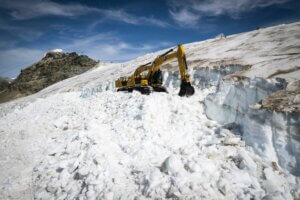High above the quaint town of Zermatt, the majestic Theodul Glacier stretches and glistens, an icy testament to nature’s grandeur. Located in the canton of Valais, this glacier, known by various names such as Theodule Glacier in English, Theodulgletscher in German, Glacier du Théodule in French, and Ghiacciaio del Teodulo in Italian, serves as an iconic symbol of the Alps.
Descending from the imposing Breithorn, which stands at 4,164 metres, the Theodul Glacier divides into two distinct branches. The Upper Theodul Glacier (Oberer Theodulgletscher) spills onto a plateau near Trockener Steg, sharing the space with the Furgg Glacier. The Lower Theodul Glacier (Unterer Theodulgletscher), on the other hand, extends until it hovers about 2,500 metres above the Gorner Glacier. Notably, the glacier’s expansive basin touches upon both Swiss territory and the Italian region of the Aosta Valley. Furthermore, the Theodul Pass, a significant alpine crossing, bisects this glacier, marking the border between Switzerland and Italy and forging a connection between Zermatt and Breuil-Cervinia. The iconic Matterhorn, with its characteristic pyramid shape, casts its shadow upon the glacier’s western side.
Yet, a controversial decision threatens to mar this pristine beauty. The Swiss are excavating the glacier, a move seen by many as an ecological anomaly. The reason behind this significant undertaking? To carve out a ski slope for the upcoming World Ski Championships scheduled for mid-November. Some view this as a reflection of misplaced priorities, especially in the context of the pressing concerns surrounding climate change.
The financial allure of the event, projected to generate over a hundred million Swiss francs from advertising alone, seems to overshadow the ecological implications of such an endeavour. Moreover, reports suggest that the excavation activities have encroached upon protected areas. Although organisers claim to possess the requisite permits, they’ve refrained from making these documents public, leading to ambiguities regarding the project’s legality.
The silence from the Zermatt municipality further fuels these uncertainties. But more than the potential legal implications, the environmental concerns loom large. The unsettling reality is that projections indicate the glacier’s size will diminish by half by 2028.
Many voices have risen in protest against this initiative. Notably, Alexis Pinturault, a three-time world champion, expressed his dismay, stating that the event is out of touch with current times and has provoked widespread shock. He emphasised the ill-advised nature of damaging a glacier for a mere competition. Pinturault’s perspective reflects a broader sentiment: the need to adapt to climate change, possibly by amending competition schedules rather than relentlessly clinging to set dates at the expense of nature.
With luxurious cable cars, complete with heating features, waiting to transport visitors to the top of the newly-crafted slopes, one can’t help but ponder the cost of such luxury – not in monetary terms, but in the context of nature and sustainability.

